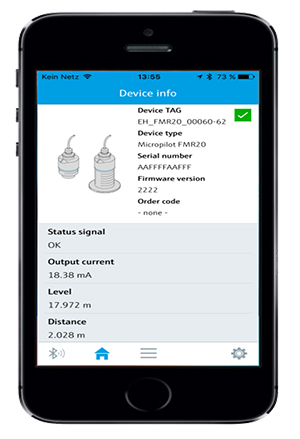Smart Instrumentation
Increase insights and efficiency with smart instrumentation
By analyzing available instrument data, processors can improve their operational efficiency while performing proactive maintenance to reduce costly downtime.

Smart sensors/transmitters provide not only sensor data, but maintenance data as well—and whether wired or wireless—let operators connect to them directly through Bluetooth or remotely through plant wireless networks. Many sensors also provide more than one process variable, such as pressure and temperature or flow, pressure and temperature. Photo courtesy Endress+Hauser
In the age of Industry 4.0, professionals in many industries are going to great lengths to identify production-enhancing insights from their data. These insights help increase efficiency throughout operations, increasing uptime and cutting maintenance costs, but adoption in the food & beverage (F&B) industry is trailing others (Fig. 1).

Fig. 1: A 2020 Accenture global survey of 600 industrial companies shows digital adoption varies greatly by industry. The chart shows high, low, and mean digital adoption percentage of respondents, with Consumer Goods and Services trailing the pack. Image courtesy of Endress+Hauser
At the heart of the issue, adoption is trailing in F&B due to a lack of awareness of the digital capabilities already present in existing instruments. And secondly, the level of communication among processors, original equipment manufacturers, and integrators is not where it could be. By increasing collaboration, F&B facility design can increasingly take advantage of digital instrumentation tools.
While the benefits of automation and equipment upgrades have not always outweighed the costs, the scene has changed in the last few years with the widespread advent of smart instrumentation. In today’s data-centric landscape, smart instrumentation provides a wealth of diagnostic and other information, enabling plant staff to get far more from their instruments than a single 4-20 mA primary process variable.
This added information, transmitted from instruments to host systems via digital communication protocols, helps plant personnel improve efficiency and avoid unplanned shutdowns by empowering them to implement proactive maintenance and predictive monitoring (Fig. 2).

Fig. 2: There is a window in which proactive diagnostic data monitoring can reveal measurement issues prior to instrument failure. Image courtesy of Endress+Hauser
Engineers, managers, and operators in the F&B industry are observing their peers in other industries, who are often farther down the path of digital transformation, and—encouraged by the results—are beginning to also embrace the digitalization trend.
Challenges for adoption
Processors must weigh the payoffs of instrument and data upgrades with installation costs and document control implications to justify efforts prior to entering change protocol and modifying control loops. By charting a strategic course before upgrading, F&B processors can ensure the availability of diagnostics and information, which can be used to effectively generate insights for improving operational efficiency and production.
Installing smart instrumentation that supports digital protocols is the first step, but there are additional challenges once this is in place. More geographically dispersed processes, such as in the water/wastewater or oil & gas industries, can take full advantage of wireless protocols for communication among digital devices. But F&B facilities often require alternative communication plans due to tightly packed machinery and steel walls, stifling wireless communications (Fig. 3).

Fig. 3: Food & beverage facilities house a high volume of steel, posing a challenge for wireless communication. Image courtesy of Endress+Hauser
To circumvent this obstacle, it can be necessary to install several wireless communication gateways. Additionally, instrumentation in F&B facilities must be able to withstand washdown, a characteristic that is not always present on digital devices.
Traditional instrumentation shortcomings in a digital age
Despite upgrade challenges, the consequences of standing still are more serious. There are many factors that can interfere with the performance of an instrument’s output, and operators may not know whether the 4-20 mA current signal processed by a programmable logic controller, distributed control system, asset management system or other host system is accurate.
Each traditional 4-20 mA instrument scales a single process value as electrical current, omitting the ability to transmit secondary variables, such as temperature on a pressure instrument. Additionally, communication is one-way only, so there is no means by which to send commands from a host system to an instrument.
Traditional analog instrumentation also lacks diagnostic information, making it nearly impossible to foresee instrument failure. These failures can cause unplanned downtime and costly instrumentation repairs in the best cases, or catastrophic equipment damage and safety hazards in the worst.
Superimposed digital data provides digital transformation avenues
By incorporating smart instrumentation into plant designs, facility operation and optimization become much more manageable tasks. These instruments incorporate digital communication protocols, sometimes in place of—and other times on top of—traditional analog communication protocols, greatly increasing capabilities and value.
For retrofitted applications where hardwiring transmitters back to a host system is convenient, instruments can use the two-way digital HART communication protocol, which is superimposed on the analog current loop, to enable sending and receiving of data with a calibration device or host system. The exchanged data includes diagnostic, calibration, maintenance, process and other information, greatly increasing configuration ease and operational process insights compared to traditional analog-only instrumentation (Fig. 4).

Fig. 4: An Endress+Hauser smart Coriolis flow meter (middle) and iTHERM TrustSens temperature probe (left) digitally transmit primary and secondary process variables—plus instrument diagnostic data—to a central host system via HART, superimposed on their analog 4-20mA loops. Image courtesy of Endress+Hauser
An estimated 80% of instrumentation used for real-time control and monitoring in the F&B industry already supports HART, but many processors are not using it, often because they are unaware. HART-enabled instruments can transmit multiple process values to a host system, providing flexibility to continue using analog loops for real-time control, while leveraging additional process and diagnostic data to make data-driven decisions.
Transmitting this data is also possible via many Ethernet-based protocols. These provide several of the same benefits as HART, but typically operate at much higher speeds, enabling inclusion of more information, along with faster response times.
Where wired implementations are impossible or inconvenient, and when facility geometries can support it, wireless instruments provide solutions, notably via WirelessHART, WLAN and Bluetooth protocols. Many smart instruments provide these connectivity options natively, while adapters can be added to provide this functionality for those that do not. These capabilities can be used to create a mesh network of sensors around a facility.
WirelessHART and Bluetooth instruments typically send and receive as much or more diagnostic and process data as their wired HART counterparts. While this data can provide immense benefits to a wide range of host systems and applications—such as maintenance management, asset information and health management, inventory control and enterprise resource planning systems—many facilities do not take full advantage of what this data has to offer.
Automation systems regularly use flow, pressure, temperature, level, and other process data to monitor and control processes, but they often discard status and diagnostic data. By not using this data, facilities miss out on opportunities to optimize, simplify and safeguard their plant operations.
When this data is ingested by intelligent plant analysis systems, facilities increase their ratio of proactive to reactive maintenance, thus reducing unplanned downtime, along with equipment and human safety hazards. For example, instead of waiting to receive an alarm indicating a high-pressure condition, process data can be used to generate an alert when conditions are detected that would lead to this type of issue. When this diagnostic data is integrated into host systems, it can be analyzed to provide advance warning of instrument failure, or troubleshooting insight in the event of failure.
Bluetooth interfaces complement diagnostic data
Many smart instruments include Bluetooth interfaces accessible via a smartphone or tablet, making it easier for technicians to monitor instrument health. With proper authorization, they can also change tags and other configuration parameters without any industrial network configuration because the mobile device handles the communication (Fig. 5).
 |
|
Fig. 5: Using the Endress+Hauser SmartBlue app, maintenance staff can view instrument data, configure settings, and walk-through instrument troubleshooting procedures via a Bluetooth connection. Image courtesy of Endress+Hauser |
These interfaces include guided procedures for in-situ testing, and they provide traceable verification logs because records are stored in instruments’ local memory. These procedures comply with NAMUR NE107 for instrumentation verification without interrupting the process, eliminating the need for device removal and process downtime.
Third-party attested verification and automatically generated verification reports enable optimization of calibration and proof test cycles in a compliant manner. And when anomalies or issues are detected, Bluetooth smartphone interfaces provide easy-to-follow recommendations for remedial actions.
Digitalization case study: Whey, water, and CIP detergent phase separation
Many F&B processors still operate clean-in-place (CIP) systems with little automation, relying on timing-based processes and manual verification. These manual procedures require attention to detail and highly experienced operators, making them prone to error.
By installing Endress+Hauser OUSAF11 optical absorption smart instruments, a cheese processor was able to successfully detect phase separation and reduce product loss in its CIP process, simultaneously eliminating variability between cycles and reducing the likelihood of human error (Fig. 6).

Fig. 6: CIP procedures require precise phase triggers and attention to detail to ensure acceptable sterilization and maximum process efficiency. Image courtesy of Endress+Hauser
Additionally, the plant reduced waste and shortened rinse cycles by implementing conductivity instruments and online diagnostics, eliminating reliance on guesswork and timing, and providing additional benefits:
- Shortened each CIP cycle by 15 minutes.
- Reduced CIP chemical usage by 32%, saving over $5,000 in three months on chemicals alone.
- Reduced energy and water usage.
- Decreased wastewater generation.
- Increased equipment availability for processing by more than one hour per day.
- Reduced detergent usage from 3-4 to 2-3 drums per month.
By continuously monitoring the diagnostic data and multiple process variables reported by these instruments, the processor can now preemptively service its instrumentation and equipment to prevent failure and increase uptime. And online verification capabilities eliminate the need to take instrumentation out of service for most calibration procedures.
Look to the cloud for additional benefits
By installing smart instruments and monitoring their diagnostic and process data in edge controllers or software in the cloud, F&B processors can:
- Preemptively detect and mitigate instrument failure, reducing downtime.
- Migrate from reactive maintenance procedures to predictive maintenance programs by leveraging process diagnostics and anomaly detection.
- Analyze secondary process variables to make better-informed operational decisions.
- Place higher trust in instrument measurements.
- Eliminate failures caused by measurement errors.
- Perform online calibration, reducing human and process risks.
- Store and retrieve instrument verification records directly at the device.
- Troubleshoot and remediate issues quickly, empowered by clear and standardized diagnostic messages according to NAMUR NE 107.
When seeking to optimize plant processes, smart instrumentation provides indispensable data, which can be used to create operational and maintenance insights. This is done by utilizing digital communication from smart instruments to host systems and by analyzing multivariable process values and diagnostic information (Fig. 7). These insights help improve process efficiency and assist in avoiding unplanned shutdowns by supporting proactive maintenance procedures.

Fig. 7: Endress+Hauser’s cloud-based Netilion ecosystem aggregates data from multiple vendors, unifying instrument information and asset insights in a central repository. Image courtesy of Endress+Hauser
Regardless of their progress on the digital transformation journey, F&B processors can increase operational efficiency by using existing or installing new smart instrumentation throughout their enterprises, along with software systems that continuously monitor process and diagnostic data. These actions will help pinpoint optimization opportunities so processors can remain competitive in the digital future.
Looking for a reprint of this article?
From high-res PDFs to custom plaques, order your copy today!





